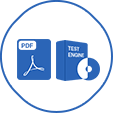Last Update 4 hours ago Total Questions : 194
The Google Cloud Certified - Professional Cloud DevOps Engineer Exam content is now fully updated, with all current exam questions added 4 hours ago. Deciding to include Professional-Cloud-DevOps-Engineer practice exam questions in your study plan goes far beyond basic test preparation.
You'll find that our Professional-Cloud-DevOps-Engineer exam questions frequently feature detailed scenarios and practical problem-solving exercises that directly mirror industry challenges. Engaging with these Professional-Cloud-DevOps-Engineer sample sets allows you to effectively manage your time and pace yourself, giving you the ability to finish any Google Cloud Certified - Professional Cloud DevOps Engineer Exam practice test comfortably within the allotted time.
You are managing an application that runs in Compute Engine The application uses a custom HTTP server to expose an API that is accessed by other applications through an internal TCP/UDP load balancer A firewall rule allows access to the API port from 0.0.0-0/0. You need to configure Cloud Logging to log each IP address that accesses the API by using the fewest number of steps What should you do Bret?
Your organization recently adopted a container-based workflow for application development. Your team develops numerous applications that are deployed continuously through an automated build pipeline to a Kubernetes cluster in the production environment. The security auditor is concerned that developers or operators could circumvent automated testing and push code changes to production without approval. What should you do to enforce approvals?
Your company follows Site Reliability Engineering principles. You are writing a postmortem for an incident, triggered by a software change, that severely affected users. You want to prevent severe incidents from happening in the future. What should you do?
Your company runs an e-commerce business. The application responsible for payment processing has structured JSON logging with the following schema:
Capture and access of logs from the payment processing application is mandatory for operations, but the jsonPayload.user_email field contains personally identifiable information (PII). Your security team does not want the entire engineering team to have access to PII. You need to stop exposing PII to the engineering team and restrict access to security team members only. What should you do?
You support a large service with a well-defined Service Level Objective (SLO). The development team deploys new releases of the service multiple times a week. If a major incident causes the service to miss its SLO, you want the development team to shift its focus from working on features to improving service reliability. What should you do before a major incident occurs?
Your company runs applications in Google Kubernetes Engine (GKE) that are deployed following a GitOps methodology.
Application developers frequently create cloud resources to support their applications. You want to give developers the ability to manage infrastructure as code, while ensuring that you follow Google-recommended practices. You need to ensure that infrastructure as code reconciles periodically to avoid configuration drift. What should you do?
You are building the Cl/CD pipeline for an application deployed to Google Kubernetes Engine (GKE) The application is deployed by using a Kubernetes Deployment, Service, and Ingress The application team asked you to deploy the application by using the blue'green deployment methodology You need to implement the rollback actions What should you do?

